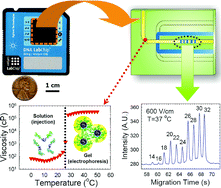Reversible thermo-responsive sieving matrix for oligonucleotide separation
Abstract
A reversible thermo-responsive gel system, consisting of

* Corresponding authors
a
Department of Chemistry, Stony Brook University, Stony Brook, NY, 11794-3400, USA
E-mail:
bchu@notes.cc.sunysb.edu
Fax: (01)63 1632 6518
Tel: (01)63 1632 7928
b Agilent Technologies, Hewlett-Packard Street 8, Waldbronn, Germany
A reversible thermo-responsive gel system, consisting of

 Please wait while we load your content...
Something went wrong. Try again?
Please wait while we load your content...
Something went wrong. Try again?
J. Zhang, M. Gassmann, W. He, F. Wan and B. Chu, Lab Chip, 2006, 6, 526 DOI: 10.1039/B515557F
To request permission to reproduce material from this article, please go to the Copyright Clearance Center request page.
If you are an author contributing to an RSC publication, you do not need to request permission provided correct acknowledgement is given.
If you are the author of this article, you do not need to request permission to reproduce figures and diagrams provided correct acknowledgement is given. If you want to reproduce the whole article in a third-party publication (excluding your thesis/dissertation for which permission is not required) please go to the Copyright Clearance Center request page.
Read more about how to correctly acknowledge RSC content.
 Fetching data from CrossRef.
Fetching data from CrossRef.
This may take some time to load.
Loading related content
